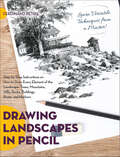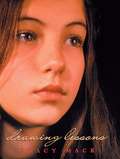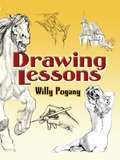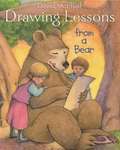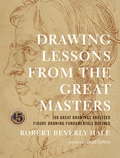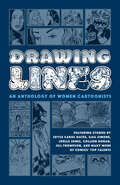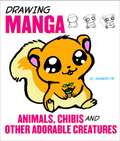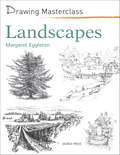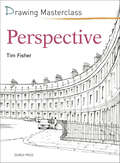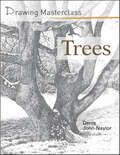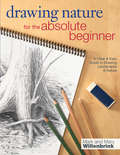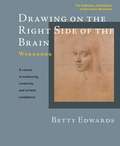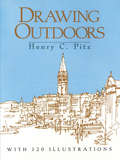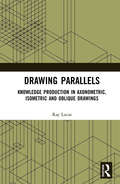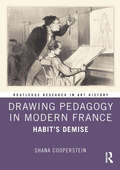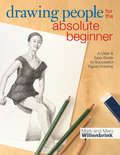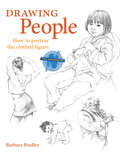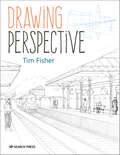- Table View
- List View
Drawing Landscapes
by Margaret EggletonArtists of all skill levels will find much to inspire them in this detailed and practical guide to drawing landscapes. Margaret Eggleton guides you through easy-to-follow drawing stages, and gives advice on using sketchbooks, line and tone, perspective and more. She shows how to draw elements of the landscape such as trees and foliage, hills and mountains, skies, water and buildings, and there are practical, step-by-step exercises throughout to help you practise the techniques.Margaret then guides you carefully through each stage of six stunning projects, each culminating in a beautiful landscape drawing you'll be proud of. Suitable for beginners wanting to build up their confidence as well as more seasoned artists seeking inspiration, this book is a must-have for anyone who wants to draw landscapes in dry media such as graphite pencils, acrylic ink, pen, Conté crayons, pastels or charcoal.This is a new, redesigned edition of Margaret's highly successful Drawing Masterclass: Landscapes.
Drawing Landscapes in Pencil
by Ferdinand PetrieComprehensive and insightful, Ferdinand Petrie's Drawing Landscapes in Pencil is full of invaluable lessons in the subtle art of pencil drawing. The course begins with a thorough overview of materials and fundamental pencil-handling skills before progressing meticulously through a series of lessons about value, form, texture, and smudging techniques. With dozens of the author's own works included as references and examples, the remaining chapters focus on rendering specific elements of landscapes like hills, trees, bodies of water, reflections, houses, cities, and more. A wonderful guide for beginners and advanced artists alike, Drawing Landscapes in Pencil will teach you to unlock the potential of the pencil.
Drawing Lessons
by Tracy MackTwelve-year-old Rory begins to lose the passion for making art that she shares with her father after she finds him kissing his female model and fears for the safety of her parents' marriage.
Drawing Lessons
by Willy PogányIn this essential guide to the basic principles of drawing the human figure, Pogany--one of the leaders of the Golden Age of Illustration--shows readers the path to artistic mastery. With a warm and supportive tone, he seamlessly blends instruction and insight with 375 masterful illustrations. The aim: to build a foundation for those who wish to draw skillfully and easily.Beginning with the humble dot and moving forward to perspective, anatomy, shading, portraiture, balance, motion, and more, this step-by-step resource is a genuine inspiration. Details of the human head, eyes, ears, and feet add depth to the instruction, followed by simple demonstrations that clearly illustrate how fundamental techniques are put into practice. Easy to follow and concise, this guide has long been considered an important resource for artists of all abilities.
Drawing Lessons from a Bear
by David M. Mcphail"You can't be a bear, you know, but you can be an artist. Are you an artist? Then say so. Say it softly to yourself, or say it loudly for the whole world to hear: I AM AN ARTIST! There. Now you are an artist. For all time and forever." From his earliest scratchings on the floor of his den to his drawings for kings and queens and princesses, this down-to-earth bear artist guides and encourages young readers to follow their dreams. Support from his mom (who hangs his first pictures on the wall of the den with magnetic rocks) and his teacher, as well as inspiration from art museums and the world around him, create an environment where the fuzzy artist can learn and grow. Warmly humorous text by David McPhail, the beloved human artist and author of more than 50 children's books (including Edward and the Pirates), will inspire bears and human beings alike to pursue their artistic aspirations.
Drawing Lessons from the Great Masters
by Robert Beverly Hale Jacob CollinsA book whose sales have not diminished but rather increased dramatically since its publication 45 years ago, this bestselling classic is the ultimate manual of drawing taught by the late Robert Beverly Hale, who's famed lectures and classes at New York City's Art Student League captivated artists and art educators from around the world.Faithfully producing and methodically analyzing 100 master drawings--including works of Michelangelo, Leonardo da Vinci, Rodin, Goya, and Rembrandt among others--Hale shows how these artists tackled basic problems such as line, light and planes, mass, position and thrust, and anatomy. With detailed analytical captions and diagrams, every lesson is clearly delineated and illustrated. Throughout, also, is commentary that sheds light on the creative process of drawing and offers deep insight into the unsurpassed achievements of the masters.
Drawing Lessons from the Great Masters
by Robert Beverly HaleThis book contains one hundred drawings by acknowledged masters, beginning with the Renaissance. They embody, or synthesize, the fundamental expression of the tradition of Western art.
Drawing Lines: An Anthology of Women Cartoonists
by Joyce Carol Oates Trina Robbins Colleen Coover Gail Simone Roberta GregoryShowcasing stories from some of the comics' greatest female creators, this anthology features stories that range from mainstream adventures to hilarious comic shorts to heart-wrenching autobiographical stories. Originally published as Sexy Chix in 2006, this new edition is presented in a new, larger size!Featuring over a dozen stories by top talents like New York Times bestselling author Joyce Carol Oates, Eisner Award-winning illustrator Jill Thompson, Scary Godmother creator Colleen Doran, DC Comics creators Gail Simone and Joëlle Jones, and many more!
Drawing Manga Animals, Chibis, and Other Adorable Creatures
by J. C. AmberlynLearn the Tricks of the Trade for Drawing Irresistibly Cute Manga-Style Animals and Chibis! The world of manga is filled with strange creatures and adorable sidekicks. Just about every manga hero and heroine has an animal mascot, and all the most popular ones have a cute "chibi" form. This book teaches aspiring manga artists how to create the funny critters that populate girls' manga and the more gritty, gothic creatures found in boys' manga. It starts with the basics of creating manga-style characters--everything from drawing heads and faces to eyes and expressions, to creating incredibly cute chibis. Part two features a valuable reference section on the mythological and real animals that have shaped Japanese artwork and stories. The final section has step-by-step demonstrations on using computer programs such as Photoshop and Corel Painter to create manga art and comics. So whether you're just starting out and want to draw a cute, simple mascot, or would like to try something more complex like an Asian dragon, or are ready to create your own otherworldly adventure, this book has something for you no matter what your skill level.From the Trade Paperback edition.
Drawing Masterclass: Landscapes (Drawing Masterclass)
by Margaret Eggleton• 6 step by step projects • Beautiful, inspiring drawings • Packed with expert advice
Drawing Masterclass: Life Drawing (Drawing Masterclass)
by Eddie ArmerEddie Armer shows how to approach life drawing in pencil, charcoal, ballpoint pen or wax crayon, using a variety of techniques.
Drawing Masterclass: Perspective (Drawing Masterclass)
by Tim FisherThis comprehensive guide shows you how to master perspective in a clear and accessible way, from simple box diagrams through to complex scenes. The book begins with a fascinating history of perspective in art, in which the author explores every type from zero to multiple-point, using numerous clear diagrams and drawings. Going beyond buildings and landscapes, he explains how to apply perspective when drawing people, animals, boats, reflections and more, and provides expert advice on drawing curved objects and inclined planes. There's also a useful run-down of common mistakes and an inspirational chapter on moving beyond a rigid application of the rules to draw freely and instinctively.
Drawing Masterclass: Trees
by Denis NaylorIn this essential addition to the Drawing Masterclass series, Denis John Naylor shows how he creates his extraordinary tree studies, from first marks made on paper to finishing touches. Denis's method is based on close observation, and here shows how to develop drawing skills as you learn techniques such as line and tone, circular toning and layering, measured drawing and creating shape, form and texture. There are detailed studies of boles, branches, leaves, bark, roots and more. Seven beautiful demonstrations show step by step how to create breathtaking drawings of this popular subject.
Drawing Nature for the Absolute Beginner: A Clear & Easy Guide to Drawing Landscapes & Nature (Art for the Absolute Beginner)
by Mary Willenbrink Mark WillenbrinkHave you ever experienced the peace of walking through the woods or the excitement of a storm gathering on a beach? Artwork provides the ability for us to capture those moments and share them with others. Drawing Nature for the Absolute Beginner offers a great beginner's course on drawing nature. In their fun and friendly teaching style, Mark and Mary Willenbrink show you how to realistically capture the world around you. All you need to get started are some simple supplies, basic techniques, and inspiration. From field to forest, beach or mountain, begin with a structural sketch, apply values and textures, and, before you know it, you'll be drawing everything you see. You'll even learn how to render favorite wildlife such as chipmunks, deer and eagles! Follow along with easy step-by-step demonstrations to draw rocks, seashells, butterflies and even more developed nature scenes. Gain a working understanding of key concepts such as perspective, value and composition. Discover simple tools and tips you can use right away to improve your art. Your artistic journey can be as pleasant as your final destination with drawing instruction meant for everyone.
Drawing On The Right Side Of The Brain
by Betty Edwards<P>Millions of people around the world have learned to draw using the methods outlined in Dr. Betty Edwards's groundbreaking Drawing on the Right Side of the Brain. In this workbook, the essential companion to her international bestseller, Edwards offers readers the key to truly mastering the art of drawing: guided practice in the five foundational skills of drawing. <P>Each of the forty carefully constructed exercises in this updated second edition is accompanied by brief instruction, sample drawings, ready made formats and blank pages on which to draw, and helpful post-exercise pointers. You will explore wide-ranging subject matter--still life, landscape, imaginative drawing, portraits, and the figure--and gain experience with various mediums, such as pen and ink, charcoal, and Conte crayon. Learning to draw is very much like mastering a sport or a musical instrument: once you understand the basic skills, you must practice, practice, practice. This brilliantly designed and practical workbook from a world-renowned art teacher offers the perfect opportunity to improve your skills and expand your repertoire.
Drawing Outdoors
by Henry C. PitzNoted artist, author and educator shows how to draw every major outdoor subject — land, greenery, skies, building, people, cities, and more — in all the major drawing media: pencils, pen and ink, brush and ink, felt pens, charcoal, Rembrandt to Wyeth. Over 100 illustrations.
Drawing Outside the Lines: A Julia Morgan Novel
by Susan J. AustinMeet the brilliant, fearless, and ambitious Julia Morgan. In 1883, eleven-year-old Julia visits the amazing new Brooklyn Bridge—an experience that ignites within her a small but persistent flame. Someday, she decides, she too will build an astounding structure. Growing up in horse-and-buggy Oakland, Julia enjoys daring fence walks, climbing the tallest trees, and constantly testing her mother’s patience with her lack of interest in domestic duties and social events. At a time when “brainy” girls are the object of ridicule, Julia excels in school and consistently outsmarts her ornery brothers—but she has an even greater battle ahead. When she enrolls at university to study engineering, the male students taunt her, and the professors belittle her. Through it all, however, Julia holds on to her dream of becoming an architect. She faces each challenge head-on, firmly standing up to those who believe a woman’s place is in the home. Fortunately, the world has yet to meet anyone like the indomitable Miss Morgan. Drawing Outside the Lines is an imagined childhood of pioneering architect Julia Morgan, who left behind her an extraordinary legacy of creativity, beauty, and engineering marvels.
Drawing Parallels: Knowledge Production in Axonometric, Isometric and Oblique Drawings
by Ray LucasDrawing Parallels expands your understanding of the workings of architects by looking at their work from an alternative perspective. The book focuses on parallel projections such as axonometric, isometric, and oblique drawings. Ray Lucas argues that by retracing the marks made by architects, we can begin to engage more directly with their practice as it is only by redrawing the work that hidden aspects are revealed. The practice of drawing offers significantly different insights, not easily accessible through discourse analysis, critical theory, or observation. Using James Stirling, JJP Oud, Peter Eisenman, John Hejduk, and Cedric Price as case studies, Lucas highlights each architect's creative practices which he anaylses with reference to Bergson's concepts of temporality and cretivity, discussing ther manner in which creative problems are explored and solved. The book also draws on a range of anthropological ideas including skilled practice and enchantment in order to explore why axonometrics are important to architecture and questions the degree to which the drawing convention influences the forms produced by architects. With 60 black-and-white images to illustrate design development, this book would be an essential read for academics and students of architecture with a particular interest in further understanding the inner workings of the architectural creative process.
Drawing Pedagogy in Modern France: Habit’s Demise (Routledge Research in Art History)
by Shana CoopersteinThis study uncovers the plethora of new, innovative drawing strategies that shaped French visual arts at the height of France’s imperial power.Horace Lecoq de Boisbaudran, Eugene Guillaume, and Félix Ravaisson, among others, designed new drawing procedures that responded to leading concerns of modern art and the exigencies of modern life: landscape painting and picturesque tourism, industrial design, and the use of drawing as vehicles of knowledge production and in social control. From graphic regimes that were “purement mathématique” and demanded the practice of orthographic projection, to those that privileged the articulation of proportions and the cultivation of an internal measuring system, fin de siècle educators in the fine and applied arts radically transformed drawing strategies and its history. The shifting parameters of drawing pedagogy and practice unfold onto a wider set of theoretical concerns central to humanistic inquiry and art-making today: the philosophy and cultural history of habit-based learning, the relation between industrialization and drawing, and the relation between art and mathematics.The book will be of interest to scholars working in art history, French studies, history of art education, history of philosophy, and history of science.
Drawing People for the Absolute Beginner: A Clear & Easy Guide to Successful Figure Drawing
by Mary Willenbrink Mark WillenbrinkYes, you can! Known for their friendly, focused, you-can-do-it approach to teaching art, Mark and Mary Willenbrink show beginning artists how to draw people in a realistic style. Inside you'll find everything you need to succeed, from how to select and hold your pencils to expert instruction on drawing hands, clothing and figures in motion. This book steers you clear of common mistakes and brings clarity to even notoriously tricky concepts like perspective and values. While the human subject is wonderfully diverse, this book teaches an easy-to-learn approach that can be used to achieve accurate drawings every time. Thirteen complete figure drawing demonstrations show how. Start with a few lines to establish basic proportions, sketch in placement lines, then gradually develop details. Before you know it, you'll be drawing people of all ages, body types and personalities! This book makes it easy to get started. The quality of your results will encourage you to keep at it, building your skills and your confidence with every stroke. What's Inside: Tricks for ensuring accurate body proportions and feature placement in your drawings. Expert advice on drawing heads, hands, legs, clothes and more. 13 step-by-step demonstrations featuring a diversity of model types, lighting and poses.
Drawing People: How To Portray The Clothed Figure
by Barbara BradleyDraw Natural and Believable Clothed FiguresIn Drawing People, award-winning illustrator and instructor Barbara Bradley provides all the information you need to render clothed human figures with energy, detail and control.Bradley begins by teaching the basics of any drawing, including proportion, perspective and value. Next, you'll learn how to overcome the special challenges posed by clothing, including fabric folds and draping effects. Bradley illustrates how they're constructed and how to draw them in different situations - on male and female figures that are active or at rest.These reliable, proven drawing techniques will add a natural feel to your art, resulting in figures that look as if they could walk, run or dance right off the page.
Drawing People: Learn How to Draw Realistic Figures, Expressive Poses, and Lifelike Portraits (How to Draw Books)
by Lise HerzogDiscover how to draw true-to-life human figures and poses with detailed step-by-step instructions and tips & tricks on the best drawing techniques. Grab your sketchbook, pens, and pencils and follow along as this instructional drawing guide teaches you everything you need to know about creating the most realistic human figures. With more than 150 easy-to-follow illustrations, Drawing People is the perfect guide for aspiring artists looking to develop their people-drawing skills. Start off simple with learning how to draw basic body shapes. By the end, you will have gained the anatomical knowledge you need to make your human figures as realistic as possible including learning to draw: · Specific muscle groups · Artistic body poses · Lifelike portraits · And much more Whether you&’re a beginner or a drawing pro, Drawing People is the perfect book for anyone looking to hone their technical drawing skills and take their illustrations to the next level.
Drawing Perspective
by Tim Fisher"...by far the best primer [on perspective] I’ve ever seen. If you have other books, throw them away and buy this. You won’t regret it." - Artbookreview.net Learn how to master perspective and create convincing drawings of the three-dimensional world with the help of artist and teacher, Tim Fisher. Every aspect of perspective, from zero- to multi-point, is explored and explained in simple terms that everyone can understand. In addition to landscapes and buildings, you will learn how to apply perspective to people, animals, boats, reflections and more. There is also expert advice on drawing curved objects and inclined planes, a run-down of common mistakes, and an inspirational chapter on moving beyond a rigid application of the rules to draw freely and instinctively. Clear diagrams and finished drawings are included throughout, along with numerous exercises so that you can put your new skills into practice. This is a revitalized edition of Drawing Masterclass: Perspective (ISBN: 9781782211112).
Drawing Pets: How to Draw Animals, Stroke by Stroke (Idiot's Guides)
by David WilliamsHow to Draw Animals, Stroke by Stroke!Books on drawing animals often leave beginning artists feeling frustrated. Does the following scenario sound familiar: You're drawn in by the beautiful final images of a drawing book for beginners, but when you go through the steps of drawing your fist animal project you realize there are lots of missing strokes to get you from one step to the next. Alas!Not with this book!In this true beginner's guide to drawing pets, not only do you get a variety of 50 animals to learn how to draw, you get them in a leveled progression that start super easy and then gradually advance as you progress through the book. You also get super clear instruction with color strokes to show you exactly what's different from one step to the next.Here's just a sampling of the 50 animals you'll learn how to draw:- Dogs (8 breeds)- Cats (5 breeds)- Horses (5 breeds)- Birds (6 varieties)- Fish (4 varieties)- Turtle- Hamster- Guinea pig- Gecko- Llama- Hedgehog- Ferret- Plus an adorable puppy, kitten, and baby chick
Drawing Political Narratives with Humor in Kashmir: Satirical Brushstrokes
by Heeba DinThis book explores the remarkable ability of political cartoons in the region to craft and preserve an alternative narrative by employing the potent tool of political humor. Over the centuries, political humor, delivered through satire, caricature, ridicule, or irony, has been a powerful instrument for scrutinizing the establishment and unveiling the shortcomings and absurdities within society. In this book, the author delves into the meaning-generational structures utilized by political cartoons to amplify the underlying political-socio-cultural ideologies. It also investigates the pivotal role of political humor in shaping and defining the discourse in Kashmir. This book sheds light on the enduring impact of satire and caricature as instruments for not only commenting on contemporary issues but also for creating and sustaining a collective memory that reflects the complex sociopolitical dynamics that have characterized Kashmir throughout its history.

